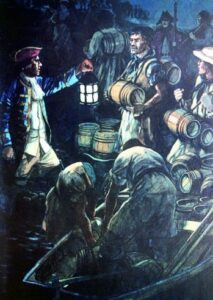One of the joys of vintage crime novels (aside from the whodunnit) is the glimpse of life from the past. With Bruce Graeme there is the added pleasure that his settings were often real places rather than an imaginary or undefined ‘—shire’. The Theodore Terhune bibliomysteries are set around ‘Bray-in-the-Marsh’ Kent, and although Bray itself is fictitious, the references to Ashford, Folkestone, Dymchurch and the coastline give a good approximate of location.
For many years Bruce Graeme (real name: Graham Montague Jeffries) lived in an Elizabethan house at Bourne Farm near Aldington, a pretty Kent village surrounded by pasture and woodland. The author was clearly very fond of his home county, and the Kent countryside is a continuing feature of the Theodore Terhune stories. In Seven Clues in Search of a Crime, Terhune is revolted at the thought of murder occuring near his home; the countryside was ‘too clean, too beautiful, with its rolling pasture land, its maze of winding hedge-bordered lanes, it orchards, its hop-fields, its quaint old cottages, sheltered farms and sleepy villages’. In Ten Trails to Tyburn, Terhune reflects on his love for rural Kent:
“Many times had he been asked why a young and intelligent man like himself was content to live his life in a sleepy, unknown little market town. Surely there could be no future for an ambitious man tucked away in a neglected corner of Kent, that could only be noted, if it could be noted for anything at all, for its serenity and the richness of its non-friable clay soil? The people who had put this, and similar questions, to him neither knew him nor Bray-in-the-Marsh……He loved the serenity of rural life, green pastures white with sheep, rippling cornfields, rose-covered cottages, squate beamed farmhouses, snug inns; he loved the smell of farmyards and hay, the fragrance of wild herbs, the tang of new-ploughed land, and above all the incense of log fires; he loved the clucking of hens, the crowing of cockerels, the bleating of lambs, the lowing of cattle, the grunting of swine, and the rattle and whirr of tractor and plough, the combined harvester and threshing machine; he loved the sight of apple orchards, lichen-covered trees, shadowy woods, haystacks; he loved deserted roads, slow-plodding horses, and the music of rippling water.”
After this ode to Kentish country living, Terhune cycles (one of the delights of this series are his travels by bicycle) past a variety of ancient manor houses, churches, farms and cottages to pursue his inquiries at an old inn. Public houses are an important backdrop to the English village (and to the crime novel), and part of the fun is seeing them feature in Terhune’s investigations: the Dusty Miller, Toll Inn, Load of Hay, The Dog and Duck, and of course The Almond Tree. The Almond Tree is the local hangout for Bray-in-the-Marsh ‘county folk’ (ie the gentry); its counterparts are the Wheatsheaf, which catered to the second strata of Bray society – the more prosperous farmers – and the Three Tuns, which was the resort of the drovers, shepherds, smallholders and local tradespeople. Such was the social organization of a mid century English village.

The Kentish weald still has a number of atmospheric and historic public houses that no doubt provided background to Graeme’s writing, but the closest was literally around the corner from his home. The Walnut Tree in Aldington, a medieval inn built during the reign of Richard II (1377-1399), was the meeting place of the fearsome Aldington Gang of smugglers who operated in the area in the 1820s. The 200-strong gang offloaded spirits, tobacco, and salt from French ships, with fighting parties armed with guns and ash staves called “batts” protecting those carrying the tubs of contraband good from the boats across the beaches and into the marshes. A light would be placed in the Walnut Tree’s window as a warning or an all-clear signal that could be seen across Romney Marsh to the sea.
The Walnut Tree must surely have been the inspiration for The Almond Tree, and Graeme put Kent’s history of smuggling to go use in the seventh Terhune mystery, And a Bottle of Rum.